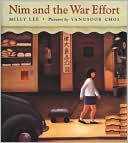This week, I worked with my students to review reading strategies. They had wonderful introductions to strategies in third grade, and really remember a great deal. I used the "Strategy Knowledge Rating" from my Reviewing Reading Strategies packet to get a snapshot of what students already know. Knowledge ratings for vocabulary can be tricky things--I've found that kids often tend to overestimate their abilities--but they are still an indicator of background knowledge.
I found that kids were very confident in their ability to predict, visualize, and activate schema, but were a little less sure of how to question, infer, and clarify. (I put the items on a chart and tabulated student responses so that we could see how everyone in the class responded.) My main goal in planning lessons for strategy use, then, was to show students how to integrate strategies, using several together to build meaning.
To model these reading strategies, and how they can all work together, I chose the book Nim and the War Effort. The muted, detailed illustrations grabbed my attention right away. But the setting and the plot made it perfect for these lessons. For my apple orchard rural kids, the Chinatown setting was new. Nim's family and culture were different than my students', but the main problem--Nim wants to collect the most newspapers to win a contest at school--was familiar. This combination of new and familiar is important for modeling strategy use. There needs to be something new to cause students to ask questions, but enough familiarity for students to be able to have some background knowledge to use for making inferences.
Day 1: We previewed the book. Students recognized that it was a narrative (hooray!) and asked questions about the pictures. We read the first few pages. After each page, I paused for students to share their questions with a partner, and then called on a few groups to share their questions for the chart.
Day 2: We continued reading, putting more questions on our chart. When we were able to answer a question, we recorded it on the chart. I led students from asking only literal questions to asking "big story questions."
Day 3: I introduced inferring. We practiced making inferences by looking at pictures from my iPhoto collection. The students know both of my sons, and so they enjoyed looking at some pictures of the boys in different seasons and making inferences about what they were doing.
Then, I told students that we can use the strategy of making inferences to answer some of our questions. We looked back at our two days of questions. Were there any that we could make an inference to answer? We read a few more pages, and then tried to answer some questions that were not stated directly in the text. I knew that we were having success when kids groaned when we finished!
Day 4: I introduced clarifying. We talked about how it's a way for us to think about the author's words and what they meant. Once again, I read a few pages, and we collected more questions and answers. By this point, the students were very invested in the story. At the pauses, kids were talkative and eager to share with their partner.
Day 5: We finished the story! What made this book perfect was the fact that the outcome of the contest was never stated directly--kids had to make an inference to figure out the ending. We talked about how, at the end of a book, we need to take some time to go back through our questions. Sometimes we'll need to make inferences to understand how it all ends.
After the whole group lesson, we practiced integrating the strategies in small groups during guided reading. I used books that were a little below the students' instructional levels:
City Green, by DyAnne Disalvo-Ryan: This book has wonderful picture support that leads students straight toward the important questions and key inferences. The name of the narrator is not revealed until page 13, making this a great book for modeling to figure out who the first person narrator might be.
Squanto's Journey, by Joseph Bruchac: I used this with a group of six boys. There were many opportunities for questioning and making inferences. The flashback structure made it a little more challenging.
Dragonfly's Tale, by Kristina Rodanas: This one was a little harder for the group. The pictures helped them to track with the story.
Train to Somewhere, by Eve Bunting: Another one with a first person narrator. Eve Bunting offers strong support for the less familiar topic. This group had some more trouble with using information from one part of the story to answer questions from an earlier part of the story.



No comments:
Post a Comment